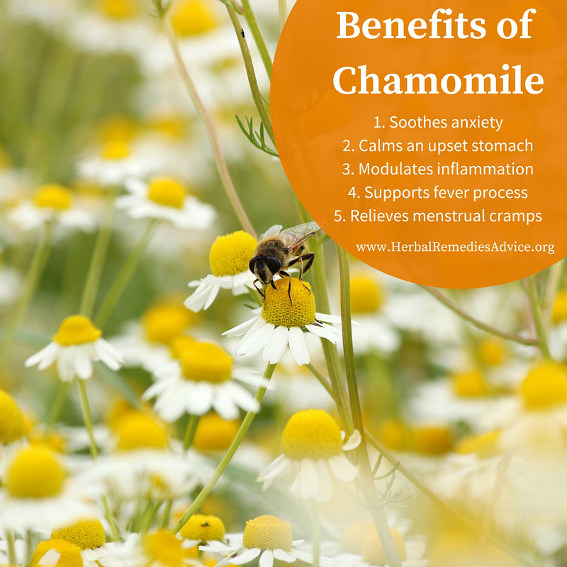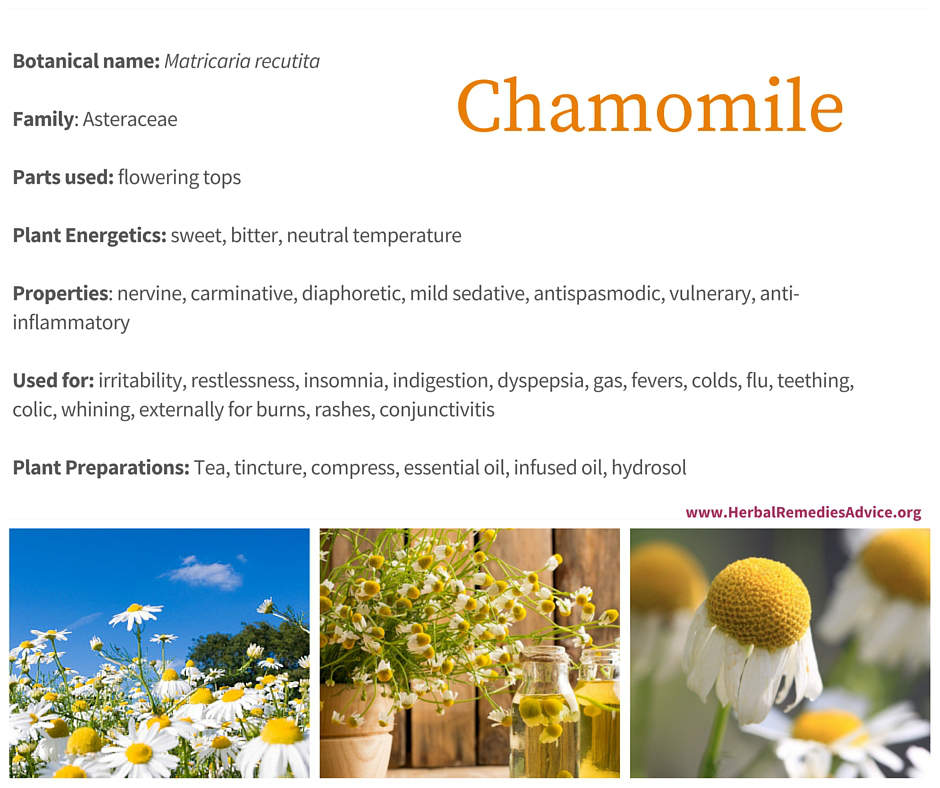Get weekly tips, recipes, and my Herbal Jumpstart e-course! Sign up for free today.
Health Benefits of Chamomile Tea
Share this! |
|
In this episode, you’ll find out how to avoid unwanted chamomile tea side effects. I also show you how to be sure your chamomile is high quality so you can get the most health benefits of chamomile tea. PLUS I’m sharing three chamomile tea recipes with you.
Chamomile, or Matricaria chamomilla, is like having an entire apothecary at your fingertips! I reach for chamomile tea to soothe an upset tummy, to relieve stress and tension, and even to promote sleep. And, of course, chamomile tea is a lovely way to relax and promote digestion after a meal.
But you need to know how to prepare it so that it matches your intended purpose…and that’s where this episode and the recipes I’m giving you come in. (Be sure to download your free, printable recipe cards!)
After listening in to this episode, you’ll know:
► How to approach chamomile tea if you’re sensitive to plants in the aster family
► The advantages to buying your chamomile in bulk
► WHEN to reach for a simple versus a strong versus a blended chamomile tea (and how to make them)
► and more…
-- TIMESTAMPS --
- 00:00 - Introduction to chamomile (Matricaria chamomilla)
- 02:44 - How to avoid chamomile tea side effects
- 04:57 - How to choose the best chamomile for the health benefits of chamomile tea
- 08:39 - How to make chamomile tea
- 10:13 - Simple chamomile tea
- 10:43 - Strong chamomile tea
- 11:49 - Rest and Digest tea blend
- 15:37 - Herbal tidbit
Download Your Recipe Card and Ebook!
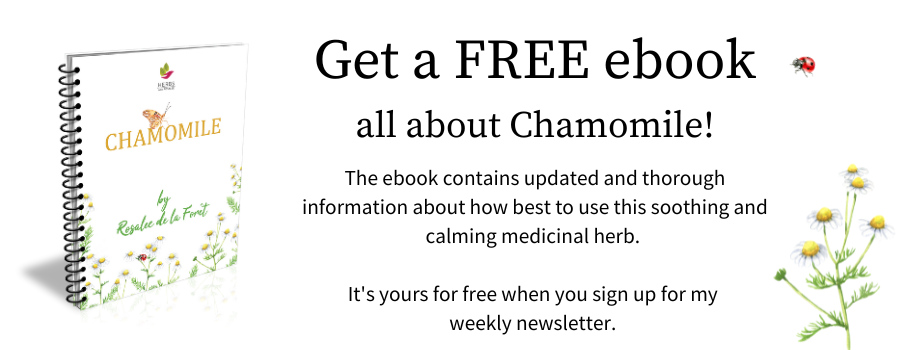
l
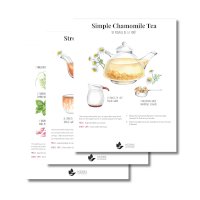
Transcript of the Health Benefits of Chamomile Tea Video
Chamomile, Matricaria chamomilla, is like having an entire apothecary at your fingertips! While many people are familiar with it as a common after-dinner tea, there’s so many more health benefits of chamomile tea!
I reach for chamomile to soothe an upset tummy, to relieve stress and tension, and even to promote sleep.
In fact there’s so many health benefits of chamomile tea that I’ve already created an entire episode for it called Chamomile Benefits. If you haven’t seen or listened to it yet, check it out after this episode. In that episode I show you exactly how to identify chamomile (Matricaria chamomilla) and how you can make your own chamomile infused oil.
This episode is all about making the best chamomile tea recipes.
Chamomile is easily one of my favorite herbs in herbal teas and I’m excited to share my best tips for getting an excellent chamomile tea for a variety of situations. Do you have experience with chamomile tea? I’d love to hear about it in the comments at the bottom of this page. Your comments mean a lot to me! I love cultivating a community of kind-hearted plant-loving folks! Plus, it’s always interesting and insightful to hear the experiences of plant lovers out there. Your suggestion may also help others!
Okay, the first thing we need to discuss before making our tea is Chamomile Tea Side Effects.
I wish everyone could enjoy chamomile tea. It’s delicious, calming, and is a wonderful tea for particular ailments, or simply to enjoy. That’s good medicine!
But, chamomile tea isn’t for everyone.
Chamomile is a part of the aster family, one of the largest plant families. One study showed that about 3% of the population has an allergic reaction to the aster family. Of those 3%, about half of them are specifically allergic to chamomile.1
If you know you’re sensitive to the aster family. Or if you know specifically that you have reactions to plants within that family such as ragweed, chrysanthemums, marigolds, or daisies, then it’s best to avoid chamomile or at least approach it very cautiously.
Here’s what I mean by that…
You could start by simply touching the plant for a bit to see if there is a contact dermatitis reaction. If not, you could gently crush the plant and smell it. See if there’s a reaction. If not, you could try very little bits of a diluted tea to see if there is a reaction. If not you can increasingly try larger amounts of the tea.
I want to emphasize that chamomile is generally regarded as safe for most people. However, if you are sensitive or allergic to this plant it can cause nausea, headaches, or an itchiness in the throat. Again, these types of reactions are uncommon but they are a possibility.
There’s also some potential that chamomile could interact with drugs like warfarin and cyclosporine. If you’re taking those drugs then it’s best to avoid chamomile or work with an herbalist directly.
The last chamomile tea side effect that I need to mention is something that can be both a benefit and a pain. Chamomile can be a diuretic, especially when taken in stronger amounts. So that’s just something to be aware of. I would avoid drinking lots of chamomile tea just before bed, a long meeting, or before a road trip.
Health Benefits of Chamomile Tea: How to Choose the Best Chamomile
My dad used to tell me that the food recipes you make is only as good as the ingredients you use. And this couldn’t be more true than in herbal medicine. If the herbs you’re making tea with are old and weak then it’s going to be tough to get a lot of medicinal benefits from them.
So before we talk about making chamomile tea recipes, we have to make sure you have the best ingredients.
While it’s common to make chamomile tea from tea bags, I don’t often recommend it.
That’s because the chamomile often found in tea bags can be very low quality. It is often simply old, or perhaps it wasn’t harvested and processed well, resulting in low quality herbal material.
An easy way to avoid low quality chamomile is to buy it in loose bulk so you can better assess the quality yourself.
However, that doesn’t mean that all tea bags are bad. There are a few companies out there that make great quality teas in tea bags. (Here are a couple: Traditional Medicinals and Pukka). To get on my top recommended lists, these companies not only have exceptional quality herbs in their tea bags, they also have companies that ethically source their herbs, pay a fair wage throughout the supply chain, and give back to those communities.
It would be impossible for me to list ALL the great companies out there so here’s some tips to assess the quality of tea bags.
The first is to look for a few certifications including organic, fair trade, and possibly, fair wild. These certifications, while not perfect, offer some accountability and show that the company is making strides to offer a quality product that not only supports you and your health but everyone involved in bringing the tea bags to you.
For more about sustainable sourcing check out my episode with Ann Armbrecht, the author of The Business of Botanicals, which is a fantastic, easy, and illuminating read that I recommend to everyone who works with herbs. Just by coincidence, that episode with Ann also focuses on chamomile, so I’m sure you’ll want to check it out.
Okay, the next step is to give that chamomile tea bag a sniff. Does it smell vibrant and aromatic? Or does it smell like straw. You definitely want chamomile that smells vibrant and aromatic!
The same goes for assessing loose bulk chamomile. In this case it’s easier to see the chamomile with your eyes. Does it still retain a bright yellow color? Or is it dulled and brown?
Choosing chamomile that is bright, vibrant, and delightfully strong smelling is just like choosing the best veggies at the store.
Given the option, you’re going to choose the deep red plump tomato, not the pale wrinkly tomato. Right? In other words, use your senses intentionally, along with a bit of common sense, and you’ll get some great quality chamomile. Also, over time, as you handle more and more chamomile, you’ll be better able to tell just how great the quality is.
So one clear advantage of buying chamomile in bulk is being able to easily use your eyes to see if the chamomile is of good quality. Another benefit is that it’s often a lot cheaper to buy it in bulk vs. a tea bag.
Having it in bulk also means that you are able to more easily choose how much chamomile you want to use for any given situation. There are times when you’d be best with just a bit of chamomile and other times when the situation is best resolved with a lot more chamomile.
Okay now that I’ve shared about chamomile tea side effects and how to choose the best chamomile for your tea recipes, it’s time to make tea!
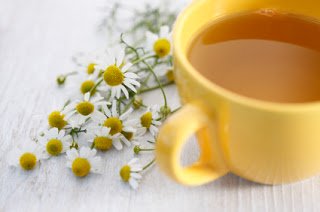
Health Benefits of Chamomile Tea: How to Make a Chamomile Tea Recipe
There are soooo many ways to make a chamomile tea recipe. In this section I am going to share three with you so that you’ll have several to choose from.
The first is a simple chamomile tea which is a great choice for maintaining health and preventing illness. This can be a great simple tea for after dinner.
The second tea is a supercharged and super strong version that is best for addressing specific ailments like intense stress, pain, and supporting the fever process.
And the last is a favorite herbal blend, one that we drink often at our house.
To make these teas you need some simple supplies.
Of course you’ll need some chamomile, hopefully you have wonderful quality chamomile.
You’ll need water that is clean and purified. For some of you that may just mean well water or municipal tap water and for others that may mean needing to buy safe drinking water.
You’ll need something to boil water.
Something to steep the tea in that has a cover. Covering your aromatic herbal teas is very important.
And then a strainer to separate the chamomile from the tea.
And lastly, all of these recipes can be made with your sweetener of choice. I prefer to add this at the end after the tea is done steeping.
Teas are water-based preparations and they don’t have any preservatives in them. As a result they can spoil fairly quickly. For best results I recommend drinking your tea the day you make it.
Okay, first up, the simple tea. This preparation of a simple chamomile tea is a lovely after-meal drink and can be enjoyed by people of all ages.
Simple Chamomile Tea
To make this you’ll need:
- 1 tablespoon dried chamomile flowers
- and 12 ounces of just-boiled water
To make this tea, steep the chamomile flowers in the hot water for five to ten minutes. Strain, add honey if desired. You can enjoy this tea warm or cold.
Our next tea is a Strong Chamomile Tea
This variation of chamomile tea is much stronger in action than the simple chamomile tea recipe. I recommend this recipe when someone is experiencing a lot of spasmodic pain such as back pain or menstrual cramps. I often recommend this when there is a fever accompanied by aches, pains and a headache. You’ll notice that this tea has a much stronger bitter taste that the simple tea, but you’ll also notice that you can really feel its relaxing and pain relieving properties.
To make this you’ll need:
- 1/2 cup (10 grams) dried chamomile flowers
- 16 ounces of just-boiled water
Steep the chamomile flowers in the hot water, covered, for 15-20 minutes.
Strain. This strong tea comes with another chamomile tea side effect. Because this tea is so strong you’ll want to drink it slowly. Drinking strong bitter drinks too quickly can result in nausea.
Our last tea recipe is my favorite Rest and Digest Tea
This is a delicious and calming blend that is a wonderful way to relax and unwind after dinner. We often drink this at our house and it’s also what I reach for when we have guests.
To make this you’ll need:
- 1 tablespoon dried oatstraw (Avena sativa) (2 grams)
- 2 teaspoons dried lemon balm (Melissa officinalis) (2 grams)
- 1 teaspoon dried chamomile flowers (Matricaria chamomilla) (1 gram)
- 1 teaspoon dried rose petals (Rosa spp.) (1 gram)
- 1/2 teaspoon dried peppermint (Mentha x piperita) (<1 gram)
- Pinch of dried lavender flowers (Lavandula angustifolia)
To make this simply steep the herbs in 14 ounces of water, covered, for 10 minutes.
Strain. Add honey if desired.
With these three chamomile tea recipes you’ll be able to make chamomile tea for a variety of situations.
If you’re interested in learning how to make medicinal teas from many other powerful herbs, then check out my Healing Power of Teas online course. In there I show you how to make effective teas that actually taste good!
Also, don’t miss out on your beautifully illustrated chamomile tea recipe cards above this transcript!
My first book, Alchemy of Herbs, shows you how to choose the best herbs for you and is has an entire chapter on chamomile.
If you enjoyed this video on chamomile tea side effects, the health benefits of chamomile tea, these chamomile tea recipes, and you value trusted herbal information, then I hope you’ll stick around! The best way to get started is to subscribe on YouTube and your favorite podcast app.
One of the best ways to retain and fully understand something you’ve just learned is to share it in your own words. With that in mind I invite you to share your takeaways with me and the entire Herbs with Rosalee community. You can leave comments at the bottom of this page, or simply hit reply to my Wednesday email. I read every comment that comes in and I’m excited to hear your herbal thoughts about chamomile teas!

Okay, you’ve lasted to the very end of the show which means you get a gold star and this herbal tidbit…
Herbal Tidbit
I shared some chamomile tea side effects earlier in this episode. Which are potentially serious. But for your herbal tidbit, I wanted to share some more light-hearted side effects from my own personal experience.
So as you’re drinking your chamomile tea, look out for these side effects:
- A relaxed personality that stops to smell the roses rather than obsesses over to-do lists.
- Improved digestion, including less gas or bloating after meals.
- Less chronic inflammation and perhaps better blood sugar modulation.
- A desire to grow and/or store plenty of chamomile so it’s never far from you. Including tea bags that are found in your purse or travel first aid kit. Which you whip out whenever someone around you complains of a belly ache or stress.
Cheers to chamomile!
Citations for the Health Benefits of Chamomile Tea
Click to show/hide.

Rosalee is an herbalist and author of the bestselling book Alchemy of Herbs: Transform Everyday Ingredients Into Foods & Remedies That Healand co-author of the bestselling book Wild Remedies: How to Forage Healing Foods and Craft Your Own Herbal Medicine. She's a registered herbalist with the American Herbalist Guild and has taught thousands of students through her online courses. Read about how Rosalee went from having a terminal illness to being a bestselling author in her full story here.
